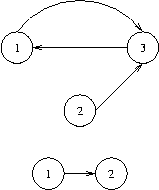The Bottom of a Graph
| Time Limit: 3000MS | Memory Limit: 65536K | |
| Total Submissions: 7514 | Accepted: 3083 |
Description
We will use the following (standard) definitions from graph theory. Let V be a nonempty and finite set, its elements being called vertices (or nodes). Let E be a subset of the Cartesian product V×V, its elements being called edges. Then G=(V,E) is called a directed graph.
Let n be a positive integer, and let p=(e1,...,en) be a sequence of length n of edges ei∈E such that ei=(vi,vi+1) for a sequence of vertices (v1,...,vn+1). Then p is called a path from vertex v1 to vertex vn+1 in G and we say that vn+1 is reachable from v1, writing (v1→vn+1).
Here are some new definitions. A node v in a graph G=(V,E) is called a sink, if for every node w in G that is reachable from v, v is also reachable from w. The bottom of a graph is the subset of all nodes that are sinks, i.e.,bottom(G)={v∈V|∀w∈V:(v→w)⇒(w→v)}. You have to calculate the bottom of certain graphs.
Let n be a positive integer, and let p=(e1,...,en) be a sequence of length n of edges ei∈E such that ei=(vi,vi+1) for a sequence of vertices (v1,...,vn+1). Then p is called a path from vertex v1 to vertex vn+1 in G and we say that vn+1 is reachable from v1, writing (v1→vn+1).
Here are some new definitions. A node v in a graph G=(V,E) is called a sink, if for every node w in G that is reachable from v, v is also reachable from w. The bottom of a graph is the subset of all nodes that are sinks, i.e.,bottom(G)={v∈V|∀w∈V:(v→w)⇒(w→v)}. You have to calculate the bottom of certain graphs.
Input
The input contains several test cases, each of which corresponds to a directed graph G. Each test case starts with an integer number v, denoting the number of vertices of G=(V,E), where the vertices will be identified by the integer numbers in the set V={1,...,v}. You may assume that 1<=v<=5000. That is followed by a non-negative integer e and, thereafter, e pairs of vertex identifiers v1,w1,...,ve,we with the meaning that (vi,wi)∈E. There are no edges other than specified by these pairs. The last test case is followed by a zero.
Output
For each test case output the bottom of the specified graph on a single line. To this end, print the numbers of all nodes that are sinks in sorted order separated by a single space character. If the bottom is empty, print an empty line.

Sample Input
3 3 1 3 2 3 3 1 2 1 1 2 0
Sample Output
1 3 2
Source
- 题目大意 若节点V所能到达的点{w},都能反过来到达v,那我们称v是sink。
- 强连通+缩点
- 就是求极大连通分量,最后统计出度为0的点,排序后输出初度为0的分量包含的每一个点。
- 不管怎么样都会存在一个出度为0的点,所以说If the bottom is empty, print empty line是没有用的。
#include<iostream> #include<cstdio> #include<cstring> #include<algorithm> using namespace std; const int VM=5010; const int INF=999999999; struct Edge{ int to,nxt; }edge[VM*VM]; int n,m,cnt,dep,top,atype,head[VM]; int dfn[VM],low[VM],vis[VM],indeg[VM],outdeg[VM],belong[VM]; int stack[VM],res[VM]; void addedge(int cu,int cv){ edge[cnt].to=cv; edge[cnt].nxt=head[cu]; head[cu]=cnt++; } void Init(){ cnt=0,atype=0,dep=0,top=0; memset(head,-1,sizeof(head)); memset(vis,0,sizeof(vis)); memset(low,0,sizeof(low)); memset(dfn,0,sizeof(dfn)); memset(indeg,0,sizeof(indeg)); memset(outdeg,0,sizeof(outdeg)); memset(belong,0,sizeof(belong)); } void Tarjan(int u){ dfn[u]=low[u]=++dep; stack[top++]=u; vis[u]=1; for(int i=head[u];i!=-1;i=edge[i].nxt){ int v=edge[i].to; if(!dfn[v]){ Tarjan(v); low[u]=min(low[u],low[v]); }else if(vis[v]) low[u]=min(low[u],dfn[v]); } int j; if(dfn[u]==low[u]){ atype++; do{ j=stack[--top]; belong[j]=atype; vis[j]=0; }while(u!=j); } } int main(){ //freopen("input.txt","r",stdin); while(~scanf("%d",&n) && n){ Init(); scanf("%d",&m); int u,v; while(m--){ scanf("%d%d",&u,&v); addedge(u,v); } for(int i=1;i<=n;i++) if(!dfn[i]) Tarjan(i); int tmp; for(int i=1;i<=n;i++){ tmp=belong[i]; for(int j=head[i];j!=-1;j=edge[j].nxt){ int v=edge[j].to; if(belong[i]!=belong[v]) outdeg[belong[i]]++; } } cnt=0; for(int i=1;i<=atype;i++) if(outdeg[i]==0) for(int j=1;j<=n;j++) if(belong[j]==i) res[cnt++]=j; sort(res,res+cnt); if(cnt!=0){ for(int i=0;i<cnt-1;i++) printf("%d ",res[i]); printf("%d\n",res[cnt-1]); }else printf("\n"); } return 0; }